An attempt at coffee-infused vodka
A mad scientician never knows when a beaker will explode or a Tesla coil will overload, so he must always be fully alert. As such, caffeine is a mad scientician's best friend. Since we began this undertaking, Wayland and I have wanted to create a coffee-infused vodka, but unlike our previous experiments, our research has failed to find much in the way of guidelines. Therefore, this will be our first off-the-cuff experiment.
The only information we could find is that this infusion should happen quickly -- within a day or two. The amount and type of beans, however, we are guessing at. Particularly, we have no idea if this should be done with roasted or unroasted coffee beans. Ultimately, we decided to use roasted beans, since we already have an impressive supply on hand.
We buy whole bean coffee from Starbucks, and grind and brew them at home. (Despite this, I have never successfully managed to order a coffee at Starbucks; their menu is in some strange foreign language that wasn't taught at Mad Scientician's Academy.) We currently have several varieties available, and decided to perform this experiment using Kenya. Why? Because Kenya's got lions. Believe it!
Brendan began the experiment by pouring some coffee beans into the jar.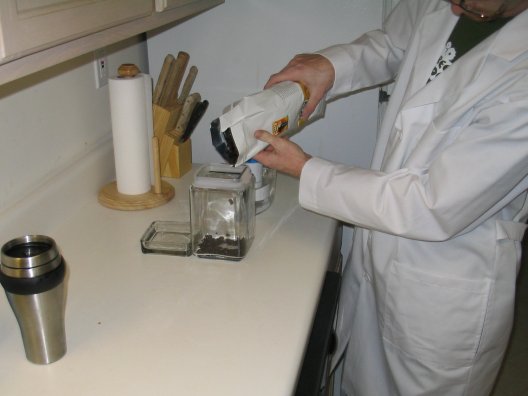
We didn't want to overdo it, since coffee has such a strong flavor, especially a bold coffee like Kenya (medium blends are for wussies). We put in just enough to cover the bottom of the jar. It's possible that even this is too much; we will find out soon enough.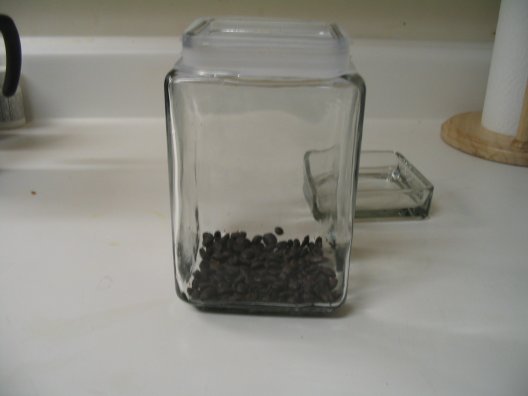
Wayland completes the initial stages by pouring the filtered vodka into the jar.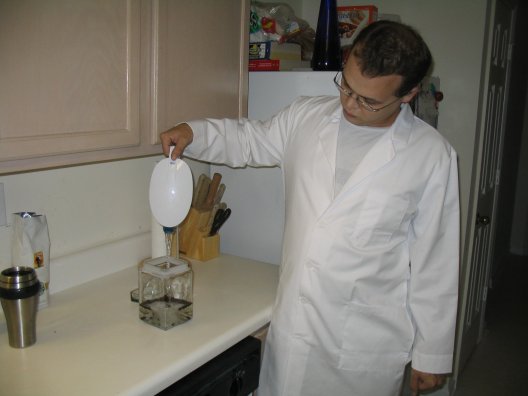
The coffee beans float on the surface of the vodka as they impart their flavor.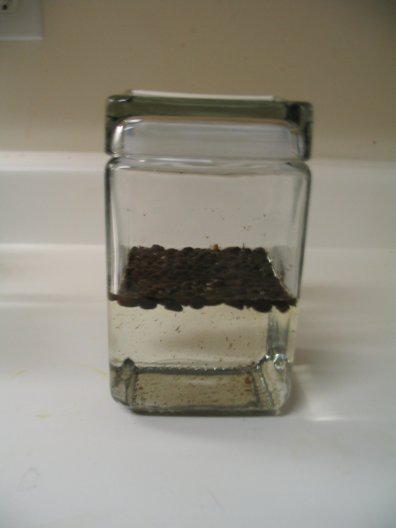
Several questions remain unanswered. We hope that the experiment will reveal these answers, though we also welcome input from our readers.
1. Will the roasted beans do, or will we have to track down unroasted ones somewhere?
2. Will the beans impart their caffeinated qualities, or merely their flavor?
3. Did we use too many beans? Too few?
4. Where the heck do you buy airtight Mason jars anyway?
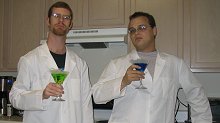
6 comments:
Unroasted coffee beans would probably not yield very good results. They are like hard waxy lumps, and what little taste they have isn't good.
As I said to Wayland...
You can't buy airtight anything. The only way to truly seal something is to boil it as you would a jar during the canning process.
And I'm guessing the beans will only give off flavor, not caffeine. But really, how will you know if it does or doesn't?
If we drink shot after shot of coffee vodka and don't pass out, we'll know it's got caffeine in it!
Hmmm.... caffeine-pill-infused vodka....
I think your coffee vodka extraction method is flawed: you should use ground coffee instead of whole beans. (as is standard practice)
I ran an off-the-cuff version of this experiment with ground beans (Moch-Java, unfiltered Stoli, mason jars, 36 hrs), and got this. (ethanol on the left, water on the right) It looks like coffee, tastes like coffee, and mixes with Bailey's like coffee. (well, it curdles milk, but still...) It's your duty as scienticians to verify these experimental results. :)
We'll give it a try at some point, but I disagree that our methodology is flawed. The results speak for themselves; it's not very good as a straight shot, but mixes beautifully with Irish cream.
As a coffee roaster, I think I can offer some answers...
1. Unroasted coffee would only give you a grassy tasting shot, as unroasted coffee really has no hint of what people know as coffee.
2. The caffeine should stay, just as it does when you brew coffee, or tea. Keep in mind, though, that the lighter the roast, the more caffeine is present in the bean.
3. I'm sure you've used too few beans. The Ferrett described an intense bitterness in the final product, and that bitterness is almost certainly the result of over-extracted coffee. This is why most people don't like straight espresso, because the barista is over-extracting the coffee. So the answer, then, should be using more coffee (the standard is two tablespoons ground coffee per 6 ounces of water, to prevent over-extraction), and maybe to not let it sit for too long. The real issue, of course, is that coffee is meant to be extracted at a nearly boiling temperature (200-204 degrees fahrenheit), and a hot infusion would destroy the alcohol. So, it's tough.
I can't stand by my hypothesis until either I or you experiment, of course, but until then, I'll continue sipping my honey vodka and cheers-ing to you.
Post a Comment